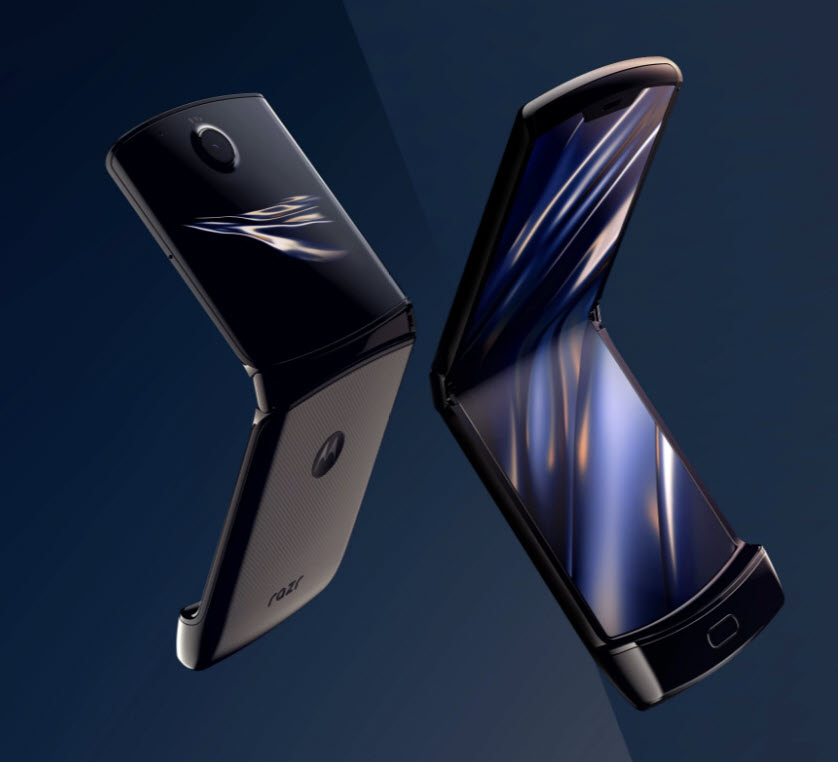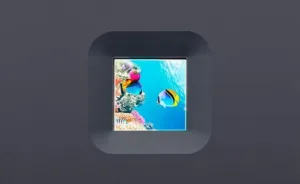It is that time of the year again – the time to review the outlook for display industry trends in 2020.

Foldable AMOLED: Shifting to new clamshell designs
Starting from 2020, foldable smartphones will be shifting more towards a new clamshell design away from the folding book type. Motorola has already launched its first foldable smartphone “razr” in a clamshell form factor with expected availability in January 2020. More brands are expected to join in.
For a foldable display, all the layers within the panel should be foldable, durable, and transparent with a total bending radius of less than 1.5 mm. Clamshell designs have smaller seams, hinges and foldable marks that can result in higher yield, lower cost, and longer usable life leading to higher consumer acceptance rate.
Clamshell designs with ultrathin glass can bring higher hardness, better scratch resistance compared to cover film. Samsung is expected to bring a clamshell design foldable smartphone with ultrathin cover glass to the market in the first half of 2020.
Samsung Display, BOE, Royole and AUO had dedicated foldable display capacity in 2019. LGD, CSOT and Visionox will join in 2020. Samsung, Royale and Huawei already have first generation foldable smartphones (in the $1300 to $2600 range). Higher prices, reliability and design issues have resulted in limited shipments in 2019. Xiaomi, TCL, Google and many others are also working on foldable phones. Lower cost, higher reliability and longer life could help clamshell design to gain higher acceptance in 2020 and drive demand.
 Motorola Razr clamshell foldable smartphone
Motorola Razr clamshell foldable smartphone
Flexible OLED: Higher market share driven by 5G
The introduction of 5G-based products needing slimmer displays to accommodate 5G enabling components will increase flexible OLED demand. Integration of new technology such as fingerprints under display, in-cell touch display, and other features to reduce border & increased screen to body ratio can open up new opportunities.
Higher costs, lower yield rates, high prices, and lack of product differentiation, seasonal demand patterns, slower smart phone market demand and an uncertain economic outlook created challenges for flexible OLED displays in 2019 leading to lower fab utilization rates and surplus capacity. Flexible OLED met only high end product requirements in 2019. Samsung Display dominates the flexible market but LGD and BOE are increasing production. More capacity will also come from companies such as Tianma, Visionox, China Star (CSOT) and others in 2020. This can help to reduce costs and improve adoption rates in 2020. More focus on cost reductions, new features, increased product differentiation, new form factors and the need for 5G-based models can bring new opportunities.
Rigid OLED had a dominant share of the OLED smartphone market in 2019. Samsung and other Chinese brands found success in meeting mid-range price requirements by reducing the price gap with LTPS LCD models, with new designs and larger sizes. Rigid OLED fab utilization rates stayed higher than flexible in 2019 leading to some suggestions that flexible fabs should convert more display to rigid format for lower costs production of thinner and lighter display that is needed for 5G applications in smartphone, notebook and tablets. Eliminating polyimide coating and producing a rigid OLED with thin film encapsulation can lead to ultra thin rigid OLED with only one glass substrate and higher yield rates.
OLED: Increased shares in TV market
OLED TV has secured a strong presence in the premium TV market. LG Electronics is the most successful brand using LG Display’s OLED TV panels. Sony, Panasonic, Skyworth, TPV, Hisense, Konka and others have joined in using LG Display’s panels. LGD is converting LCD TV capacity to OLED and is also investing an additional 3 trillion KRW into a Gen 10.5 OLED production line, mainly producing >=65-inch TV panels. The company will use the MMG method combining different sizes on one mother glass to improve efficiency and production costs. It is planning to almost double TV panel production in 2020.
BOE, and CSOT are planning to bring in OLED capacity in future years. LG Display is also working on RGB IJP (ink jet printing) technology and presented a paper at Displayweek 2019 with Nanosys about emissive QD display technology.
Samsung Display is building a pilot production facility for QD OLED (with QD Color Convertor) – see the notes later in this article.
New OLED TV technology solutions (RGB OLED, QD OLED,..) combined with printed manufacturing capabilities have the potential to enable lower-cost solutions and higher adoption rate. This year many panel suppliers (JOLED, BOE, CSOT, SDC, AUO) were able to demonstrate inkjet printed (IJP) OLED displays in various conferences and some will start mass production in 2020. First commercialization of soluble OLED panel is expected to be from JOLED’s new 5.5 Gen fab with mass production in 2020. IJP can enable higher display performance by enabling top emission large panels; this will facilitate the 8K revolution in OLED TV and increase optical performance.
Quantum Dot: Entering expansion phase
Quantum dot display will be entering an expansion phase in 2020 with lower prices, availability of TV in many sizes, and more expansions into other applications such as monitors and notebooks. Samsung Display has announced its plan to invest 13.1 trillion won (about $10.5 billion) up to the year 2025 in QD-OLED TV R&D and production line. It will convert LCD production line to QD-OLED. The new QD-OLED TV line (8.5 Gen) is expected to start production in 2021.
QD technology has been already driving gaming monitors. Samsung has also announced recently QD-enabled notebooks with higher brightness and lower power consumption. Besides Samsung, Vizio, TCL, Hisense and Xiaomi have joined in for QD TV. During Black Friday, Samsung’s QLED TV reached $499 for 43-inch and $999 for the 55-inch size. TCL’s 65-inch QLED TV was available in Costco for $599. Lower retail prices for QD TV will drive demand.
Nanosys, the dominant leader of quantum dot materials reported 50% year over year growth in shipments in fiscal 2019. The company expects the trend to accelerate in 2020 with expanding LCD TV adoption and the introduction of QD color conversion products. QD has enabled LCD to reinvent itself with better display performance.
MiniLED: Expanded presence
MiniLED backlight displays can offer higher contrast ratio, higher brightness, deeper black, and better power consumption. It can enhance luminance and HDR in a LCD TV by increasing the number of LEDs and improving the picture performance.
TCL was first to introduce miniLED backlight-based QD TV in 65-inch (<$2000) and 75-inch (<$3000) in 2019 with more than 25,000 miniLEDs and 900 local dimming zones. The products have received very positive reviews. MiniLED-based products are already being shipped for high end monitors and notebooks.
The industry is now buzzing with rumors that Apple is planning to use miniLED backlight for its iPad and MacBook in 2020. Apple’s impact could drive miniLED demand higher. MiniLED backlights can also empower LTPS LCD in smartphones or IT products by offering higher contrast, higher brightness, faster response time, an increase in color gamut and lower power consumption.
MiniLED-based products still face cost challenges to make them competitive. In the near term, suppliers are focusing more on value-based applications such as TV, gaming, automotive and VR.
MicroLED: Steady progress
More than 130 companies are working in the MicroLED display supply chain including Apple (LuxVue), Oculus (InfiniLED), Samsung, LG Display, AUO, Sony, eLux (integrated with Foxconn group), Aledia (Intel), Lumens, Lumiode, Jade Bird, Mikro Mesa, Play Nitride, Plessey, Glo (Google), X-celeprint, Rohinni, Sony, Visionox and others.
MicroLED display has many advantages such as high brightness, ultra low power consumption, fast response time, very high contrast rate, wide color gamut, long lifetime, environmental stability, high resolution, the option of flexible backplanes and integration of sensors in the display. Its main challenges are manufacturing complexity and yield issues. Manufacturing and yield issues can become an issue in the areas of epitaxy, chip, and mass transfer, bonding, driving technology, backplane, inspection and repair. The industry is working towards resolving each of these issues.
2019 was the year of microLED prototypes where many companies showcased products at CES and DisplayWeek.
Recently JDI showcased a 1.6-inch 300×300 ( 256PPI) display based on an LTPS backplane and microLED chips developed by Glo. RiT display from Taiwan announced that it would launch its first MicroLED wearable display in 2020. RiT has a strategic partnership with MicroLED developer Playnitride. Companies are initially targeting wearable, AR/VR, digital signage, public display and automotive (HUD) applications before large volume commercialization in consumer products. Industry suppliers are all working to bring MicroLED potential to reality, but it will take time. Success will depend on its ability to scale up for volume production with competitive price performance
Japan Display 1.6-inch Micro-LED display
LCD: Continued dominance in TV
LCD TV panel capacity has increased substantially in 2019 mostly due to the expansion in the number of Gen 10.5 fabs. Capacity expansion and higher production combined with weaker demand have resulted in considerable oversupply leading to drastic panel price reductions. Lower panel prices have helped TV set holiday sales by allowing reduced retail prices.
Panel makers are cautious in increasing capacity and that will help to stabilize panel prices. TV vendors are ready to introduce new models. The Tokyo Olympic in 2020 may pull panel demand to be earlier in the year.
Extreme over-supply has led some suppliers such as BOE and CSOT to announce no further investment in LCD capacity. With more aggressive price reductions, 65-inch and above size TVs are expected to take a larger share of the TV market. TV brands are also developing 8K TV +5G ecosystems aggressively with 5G high speed and low latency in transmission. The new 65-inch and higher size TVs will have strong growth in 2020 due to cost reduction. – SD
Sweta Dash is the founding president of Dash-Insights, a market research and consulting company specializing in the display industry. For more information, contact [email protected] or visit www.dash-insight.com

